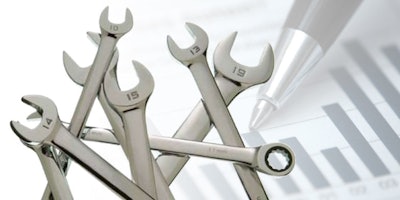
Pros
Lifecycle pricing
for service parts
Ways to stay on top of
the market and ahead of
competitors through
innovative pricing strategies
Lifecycle Pricing for Service Parts 3
Executive summary
Calculating the most appropriate pricing for after-market
service parts is a substantially different process from
establishing prices for core products. For starters, there's
the sheer magnitude of the task. Depending on your
industry, tens or even hundreds of thousands of unique
stock keeping units (SKUs) must be actively managed at
any given time.
Each part has its own cost structure and mean time
to failure, and many are bundled with services rather
than sold independently, thus increasing the complexity
of the pricing process. Plus, although parts frequently
make high-margin contributions to your bottom line,
the business units responsible for them are typically
resource-constrained, and pricing often comes as an
afterthought.
Those are just the internal challenges. Companies also
face considerable external pressures, including competi-
tion from third-party parts manufacturers and the fact
that that customer needs—and thus market demand—
varies considerably throughout the parts lifecycle.
In this article, we'll discuss the complexities of parts
pricing and ways manufacturers have traditionally
managed the process. We'll then present the basic
components of an effective lifecycle pricing strategy.
Finally, we'll make forward-looking recommendations
on ways to enact more effective pricing strategies that
can help boost revenues over the entire lifecycle of your
service parts.
4Traditional challenges of
implementing lifecycle pricing
Lifecycle pricing involves looking at the entire lifecycle of
a service part to determine the most appropriate price to
charge at each stage from product introduction through
retirement. But while lifecycle pricing has the potential
to substantially increase the profitability of your parts
business, the sheer mass of data involved, the lack of
maturity of supporting technology, the lack of visibility
into market and competitive prices, and organizational
challenges have previously prevented most companies
from wholeheartedly embracing this strategy.
Among other challenges you must take into account
when considering lifecycle pricing:
Large number of SKUs. Manufacturers must address
two key issues: how to effectively manage the
enormous volume of SKUs in the market—most of
which must be kept available long after the core product
has been retired—and whether it makes economic
sense to price all parts using a lifecycle strategy.
Frequent lifecycle events. Parts can move very swiftly
through their lifecycle. Manufacturers must be able
to define and capture the triggers for various lifecycle
events—including warranty expirations, sales of core
products into secondary markets, and the entry and
exit of competitors—before they can put the requisite
processes and systems in place. Only then can they track
sales volume and manage margins as parts progress
through their various lifestyle stages.
Lifecycle pricing can help balance cost and price.
Dynamic segmentation triggers. Finally, there's the
all-important task of accurately segmenting the market
given that customer needs change throughout the
product lifecycle, thus forcing continuous redefinition of
customer and market segments.
Despite these and other challenges, lifecycle pricing is
now not only possible, but a key competitive differ-
entiator. To begin with, critical drivers for improving
existing pricing strategies have changed. For example,
after-market parts are increasingly viewed as an
important source of revenue that can either help
manufacturers better manage the cyclical nature of core
product sales or sabotage overall profit margins. There’s
also a growing need to understand two things better:
internal cost and pricing activities, and external market
dynamics.
Finally, technology is now mature enough to help you
manage the vast amounts of data required to carry out
a lifecycle pricing strategy. Many companies have ERP
or similar systems that contain the data required to
design and monitor an excellent pricing strategy. Newer
software tools, with greater analytical capabilities for
everyday users, are becoming available as well. While
these capabilities are novel now, they’ll soon become
standard among the better companies in every industry.
Technology is now mature
enough to help you manage
the vast amounts of data required
to carry out a lifecycle pricing
strategy.
• Suply chain /
inventory costs
• Regulatory requirements
• Supplier limitations /
restrictions
• Contractual
requirements
• Raw material
fluctuations
Cost Price
• Dealer / Distributor
economics
• Warranty prices
• Margin expectations
and requirements
• Impact on core product
lifetime costs
• Competitive replace-
ments (imported
knock-off parts)
Lifecycle Pricing for Service Parts 5
Possible parts
pricing strategies
Depending on how a manufacturer currently sets
pricing, it can reap additional revenues—and increase
its profit margins—by progressing upward through the
price maturity model (see Figure 1). The stakes for doing
this are high: even if a company currently makes the
right pricing decision 90% of the time, an additional
2% improvement in pricing accuracy can add millions of
dollars to the bottom line.
The level of maturity of a manufacturer's current pricing strategy
should drive investment in additional pricing strategies.
Cost-plus pricing. Currently the most widely practiced
strategy, this involves taking the cost of a part and
marking it up to achieve a desired margin. But cost-plus
pricing can result in missed opportunities. First, it can
be difficult to capture all the relevant costs associated
with making/acquiring, selling, and distributing a part.
Secondly, this pricing model causes manufacturers
who effectively negotiate better prices with suppliers
to pass those cost advantages on to customers rather
than leveraging the savings to improve their own profit
margins. Finally, your customers are immediately and
directly affected every time your suppliers raise prices,
which can make your own pricing appear arbitrary,
volatile, and driven by market whims.
Competitive pricing. A more sophisticated pricing
strategy involves actively monitoring competitors' prices
and adjusting yours accordingly. This approach can work
very well in some conditions as it keeps your pricing in
line with the market and prevents lost revenue due to
prices set either too low or too high.
Point-of-sale pricing. Point-of-sale (POS) data that
details channel partner transactions with end customers
is increasingly available. This can help you analyze how
revenues and margins are distributed throughout the
value chain, and provides you with valuable information
on the competitive landscape, including market share,
customer loyalty, and price sensitivity.
Lifecycle pricing. This "Holy Grail" of service parts
pricing involves performing a detailed analysis of
product and customer segments and using all the above
pricing strategies at different points of time as appro-
priate. Additionally, by managing large disparate sets of
data while institutionalizing disciplined organizational
processes, you can sustain the most appropriate pricing
over time.
Figure 1: Pricing Maturity Model
Low
High
Pr
ofi
t i
m
pa
ct
HighCost to implementLow
• Pricing based upon predicted
market conditions; internal
and external feedback
• Sophisticated ABC
• Total value chain included
in price
Preemptive
Sample identifying Characteristics
• Context-drive pricing
• Prices composed of multiple
factors
• Effective traditional costig
• Moderately strong marketing
and price analysis
Adaptive
• List-based pricing based upon
perceived market conditions
• Moderately sophisticated
approach to costingReactive
• Cost-based pricing
• Rarely price sales-oriented
services
• Limited understanding of cost
and cost drivers
(no activity-based costing)
Primitive
6Key components of
lifecycle pricing
The drivers for more effective pricing strategies, coupled
with the increased availability of supporting technology,
are causing more and more manufacturers to turn to
lifecycle pricing. There are four key components you
need to address to effectively implement it: segmenta-
tion, competitive alignment, data, and process.
Segmentation
Segmentation is the process of dividing a market into
different categories, or segments, each of which has
distinct needs or ways of behaving. By identifying these
segments, and creating specific pricing plans to satisfy
the needs and/or expectations of the customers in each
one, manufacturers can begin to formulate strategies for
getting the most revenue (“value”) through the lifecycle
pricing of selected parts.
Segmentation is the heart of an effective lifecycle pricing
strategy. However, it's important to remember that
although you can segment a market any number of
ways—by product attribute, geography, or customer
demographics, among other things—manufacturers
need to view segmentation from a customer-needs
perspective. This can be accomplished through conjoint
analysis, interviews, surveys, or online tools, and can
be useful at illuminating the ways customers view parts
over the course of their lifecycles. It can also challenge
your assumptions about how to best approach the
market.
Segmentation should be implemented in three distinct
steps.
Step 1: Identify which parts should be lifecycle
priced. To prioritize resources, it’s first important to
determine which parts to price using a lifecycle pricing
strategy. As a starting point, you could determine the
relative degree of differentiation and sales volume of
various parts (see Figure 2). In this specific example,
it makes little sense to lifecycle price proprietary low-
volume products. Neither does it pay to lifecycle price
high-volume, off-the-shelf parts. However, parts that fall
into other boxes of the matrix will probably benefit from
lifecycle pricing.
Segmentation Step 1 - Not all parts need to be
lifecycle priced
• To prioritize resources, it is first important to determine
which parts do we need to life cycle price?
• The matrix below is a potential starting point for
further segmentation.
Not all parts need to be lifecycle priced.
Low Volume Captive
Low Volume Captive
Low Volume Captive
Life cycle Pricing
Life cycle Pricing
Life cycle Pricing
Commodity Pricing
Life cycle Pricing
Life cycle Pricing
Figure 2: Selective Lifecycle Pricing
Lo
w
H
ig
h
M
ed
iu
m
Pr
od
uc
t
D
iff
er
en
ti
at
io
n
Product Replacement Rate
Note: These are thought starters and potential approaches. This is not based on actual data.
HighMediumLow
Lifecycle Pricing for Service Parts 7
Step 2: Determine which lifecycle events should
trigger segment and pricing changes. There’s any
number of lifecycle events that should cause you to
re-evaluate your segments and pricing strategies. These
include, but are not limited to, the end of the core
product's warranty period; the point at which competi-
tion may enter the market; and the point where compe-
tition may exit the market (see Figure 3). All these events
must be tracked closely at the part level over the entire
lifecycle of the part.
Segmentation Step 2 - What are various life cycle
events that should trigger changes in segments and
pricing strategies
Different life cycle events and pricing triggers should be
tracked closely at a Product level, such as:
• End of warranty period
• Competition enters
• Competition exits
Different lifecycle events and pricing triggers should be tracked
closely at the product level.
Figure 3: Lifecycle Events that Trigger Segment and Pricing Changes
0
12 141082 64
Business
Strategy
Market
Impact
Pricing
Power
Price
Structure
Price
Level
Age
Sa
le
s
($
m
ill
io
n)
Note: These are thought starters and potential approaches.
This is not based on actual data.
Manage
warranty
costs
Competitive Pricing.
Margins vs
Volume tradeoffs
Competitions
enters
Competitions
begins to exit
Captive pricing.
Higher margins
Standard
Product
Lifecycle
High servicing and
inventory costs.
Manage costs to
optimize margins
8Step 3: Take into account other key segmentation
guidelines. Once you’ve decided which parts are to be
lifecycle priced and what events should trigger adjust-
ments to your segments and pricing, there are a number
of other guidelines that can help you effectively segment
your parts business.
• Perform a multidimensional analysis of parts to
further identify segments. This involves looking at
the degree of differentiation, the value proposition—
including product availability and quality—replace-
ment rates, market share, purchase loyalty, and price
sensitivity across the lifecycle of each product.
• Segment on an iterative basis. By building a history
of transactions for a particular segment or sub-
segment, you can gain insight that can be applied to
other segments and sub-segments in a cost-efficient
manner.
• Don't over-segment. Once you realize the power of
segmentation, resist the temptation to use the vast
amounts of data available—demographic, geographic,
or economic—to create too many segments. Keep
in mind that too much information can muddy the
picture. Instead, gain a clear understanding of your
customers' needs, and then layer the various stages of
the product lifecycle on top of that rather than getting
bogged down in the details.
• Focus your attention. Typically, manufacturers follow
a 90/10 rule with service parts, where 10 percent of
products drive the majority of revenues, and therefore
get the most pricing attention. Yet precisely because
these parts are so visible, you’re almost instantane-
ously aware if a competitor enters the market, or
if sales begin to drop off, and can take appropriate
action. Segmentation is especially helpful with the
other 90 percent of parts, as it provides you with
greater clarity on what prices to apply to them at
different points in their lifecycles.
Competitive Alignment
Analyses of prices on competitive products are not
widely used to set parts prices today. Yet without
considering what other manufacturers are charging for
their products, you could lose a lot of money.
A major challenge is that third-party manufacturers are
always looking for opportunities to make money off of
parts with high profit margins that are relatively easy to
reproduce. And, while you have an entire portfolio of
tens or even hundreds of thousands of SKUs to manage,
competitors can cherry pick the ones with the greatest
revenue potential.
The fragmentation of distribution channels, lack of
knowledge about when other businesses enter and
exit the market, and the prices they charge based on
lifecycle considerations increase the complexity of
battling competition. And competitors can also focus
on other value propositions than price, such as quick
turnaround time for delivering specified parts
There are four basic steps to address competitive
alignment.
Step 1: Perform research. First, determine the lifecycle
stages at which competition exists. This data must be
collected on a frequent basis so you can benchmark
prices as related to the competition, track competitors'
response to your pricing changes, and monitor pricing—
both yours and your competitors'—throughout the
parts lifecycle.
Step 2: Set pricing. You then have to reposition your
price relative to the market. This includes monitoring the
price of a part throughout its lifecycle. However if you’re
a premium brand with high customer loyalty, you might
not necessarily always want to reduce your prices to
meet those of competitors'.
Step 3: Renegotiate costs. Depending on what your
competitive analyses tell you, you may need to rene-
gotiate costs with your supplier if you hope to make a
reasonable profit on your parts.
Step 4: Test your prices. Perform a pilot test to
determine if your new prices are working. Track market
reaction over time and modify as necessary.
Lifecycle Pricing for Service Parts 9
Data
Fundamental to a lifecycle pricing strategy is the data
behind it. This includes product information across a
number of dimensions at the transaction level, and
includes all costs incurred at the point in the lifecycle in
which the transaction occurred.
You face a number of challenges related to managing
the volume and complexity of the data you will collect.
After all, data typically resides in multiple disparate
systems within the organization, as well as in third-party
systems. Additionally, you must collect data at both the
SKU and transaction level along a multitude of param-
eters, including price, cost, product replacement rates,
inventory, POS, and pricing. As some parts are involved
in as many as 25 million transactions per year, the costs
of collecting, validating, and cleansing this data is high.
Historically, this has been accomplished by tracking
a part or group of parts over the course of a year to
analyze pricing behavior throughout the entire lifecycle.
But this raises significant technological challenges. A
spreadsheet can only accommodate so many rows, and
a basic database can handle only a few million trans-
actions at most. Consequently, because service parts
transactions routinely involve at least 10 million transac-
tions, you’ll typically need enterprise-level technologies
such as SQL, Oracle, SAP, and/or custom-built software
to attempt to process all the data.
An innovative—and much cheaper—way of coping
with this is to take a single month's worth of data
for a particular part and decompose it into different
stages to piece together a picture of the entire lifecycle.
This allows you, through modeling, to create multiple
predictive scenarios, and has the advantage of involving
current data that reflects the present economic situation
as opposed to going back to a previous point in time.
Processes
The final component of an effective service parts
lifecycle pricing strategy involves institutionalizing all
actions taken thus far. Indeed, ultimately all the other
lifecycle pricing components become aspects of process.
There are three basic steps for creating processes that
are both sustainable and repeatable:
Step 1: Perform a current state assessment. Your first
move should be to perform a current state assessment,
during which you establish how you presently price
service parts. Some of the questions to be answered
during the current state assessment include:
• What’s the current process you use to set pricing?
• What sort of data do you use to price products?
• How do you collect all relevant data and translate it
into product pricing?
• Where do you stand competitively in the marketplace?
• Which original equipment manufacturers (OEMs) are
best at satisfying customer requirements?
• What do they do that you don't?
• Do you let your channel partners make enough profit?
• Are there opportunities to bundle products together
to achieve higher margins?
Step 2: Identify gaps. Once the current state assess-
ment is completed, you can identify gaps between the
way you currently do things and other more effective
practices that support lifecycle pricing.
Step 3: Design the process. This involves doing
everything from specifying how data will be collected
and compiled, to putting a framework in place to
iteratively segment the market, to involving stake-
holders in key decisions and determining ownership and
responsibility for various aspects of the pricing process.
Inevitably, you’ll need to invest in additional systems and
supporting technologies in order to manage resources
better, and change your organization so that effective
pricing strategies are easier to execute.
10
Conclusion:
Delivering impressive
returns on investment
Although it’s a big change from the way most manufac-
turers handle parts pricing, lifecycle pricing can deliver
impressive results. From our experience, the ROI of
performing a transactional pricing analysis alone—which
identifies those areas where a price is set incorrectly
based on current market conditions—can be as much as
seven times the return in margin for the upfront analytical
investment.
We have seen typical improvements from employing the
above approach and tactics to lifecycle pricing improve
the realized revenue for a part by 2% to 5%; which can
have dramatic impact where it counts the most – at the
bottom line.
Following the steps outlined here, can help your firm
transform its parts pricing strategy from a less-than-exact
science to one that establishes a dependable financial
annuity. Lifecycle pricing of service parts can help you
increase revenues, balance unpredictable downturns in
sales, and become a key competitive differentiator over
the long term.
Alice Wachol
Principal
Deloitte Consulting LLP
Tel: +1 313 324 1355
[email protected]
Manish Prabhu
Senior Manager
Deloitte Consulting LLP
Tel: +1 312 486 4843
[email protected]
Lifecycle Pricing for Service Parts 11
Deloitte’s Service
Effectiveness Dimensions
The right product at the right place at the right time at the right price. Deloitte works with the world’s leading aftermarket organizations and
solution providers to help our clients get these three factors in sync. We provide a fully integrated service offering including conceptualizing and
strategizing, enterprise applications, processes and people
Service
Effectiveness
People
Technology
Strategie
Process
People
• We have a wide range of experienced prac-
titioners in various domains and possess the
required functional / technical expertise related
to aftermarket / service operations
• We are truly a global organization that has
the capabilities to reach out to each other to
ensure that obstacles can get resolved with
the right people
• We have a vast majority of people that are skilled
in the various solution providers required to
become the service organization of excellence
Strategy
• Our executive relationships with best in class after-
market organizations to identify what is coming
up and focus upon solutions to address them
• We are singularly positioned with the
scale, scope, and multi-disciplinary capa-
bilities necessary to address the most complex
£business challenges.
• As an integrated professional services firm, we
can draw upon a broad range of financial, tax,
IT, and business process consulting capabilities to
address client needs.
Technology
• We have a unique portfolio of technology
expertise ranging in the various domains relevant
for aftermarket organizations. This build on top
of a strong Enterprise Application / Technology
Integration Practice
• We have been nominated as integration partner
of choice for multiple vendors
Process
• Based on the experiences of work performed at
best in class aftermarket companies, we estab-
lished best in class process models including a
translation towards technology solutions
• We apply globally a structured methodology and
process, along with specific tools to ensure that
our work creates solid and measurable value for
our clients.
Deloitte provides audit, tax, consulting, and financial advisory services to public and private clients spanning multiple industries. With a globally
connected network of member firms in 140 countries, Deloitte brings world-class capabilities and deep local expertise to help clients succeed
wherever they operate. Deloitte’s 165,000 professionals are committed to becoming the standard of excellence.
Deloitte’s professionals are unified by a collaborative culture that fosters integrity, outstanding value to markets and clients, commitment to
each other, and strength from cultural diversity. They enjoy an environment of continuous learning, challenging experiences, and enriching
career opportunities. Deloitte’s professionals are dedicated to strengthening corporate responsibility, building public trust, and making a
positive impact in their communities.
Deloitte refers to one or more of Deloitte Touche Tohmatsu, a Swiss Verein, and its network of member firms, each of which is a legally
separate and independent entity. Please see www.deloitte.com/about for a detailed description of the legal structure of Deloitte Touche
Tohmatsu and its member firms.
© October 2009 - Deloitte Consulting. Member of Deloitte Touche Tohmatsu
Designed and produced by the Creative Studio at Deloitte, Belgium






















